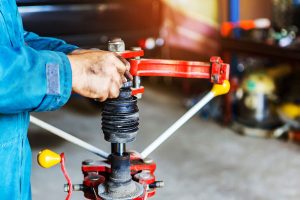Suspension Maintenance and Repair
Your car’s suspension system is just as important as the engine, since it harnesses the power created there and turns it into movement and flawless handling. Your suspension bears the weight of your car, cushions impact, and performs mile after mile with responsive steering and a smooth ride. When any of your suspension components are broken or worn down, it affects the performance of your car as a whole and can lead to more serious damage.
At Master AutoTech, we are experts in all things auto repair in Utah and Idaho. This includes your vehicle’s suspension.
Suspension is a Big Job
By the time you’ve driven 50,000 miles, your shocks and struts will have bounced up and down over 75 million times! All of this bouncing and bumping could really damage your car, but your suspension is there to make sure it doesn’t. The basic components of your suspension system include:
- Ball Joints: Facilitate movement in the suspension system.
- Control Arm: Synchronizes the vehicle’s tires and improves steering.
- Bushings: Make movement quiet and prevent metal-on-metal contact.
- Springs: Hold the weight of the vehicle.
- Shocks: Smooth out the ride and help keep the tires in contact with the road.
- Struts: Combined shocks and springs.
Wear, Tear and Repairs
Normal wear and tear on your vehicle makes it so that suspension components will probably need to be replaced about every 50,000 miles. Accidents, towing heavy loads, off road driving, or even driving over a pothole could cause damage that would require repairs before the 50k mark, though. If your car is showing any signs of suspension trouble, it’s best to get it inspected right away. Ignoring the problem could cause damage to other components in your car, and makes driving unsafe.
 Signs of Trouble
Signs of Trouble
There are lots of common car problems that stem from the suspension system since these components bear the main brunt of your day to day driving. Signs of suspension trouble include:
- Uneven tire wear
- Vibration
- Rattling or clunking sounds
- Pulling to one side
- Shocks bottoming out
- Bouncing
- The front end diving when you stop, and rising when you accelerate
- Oil leaking from suspension components
In order to avoid suspension problems, and to catch any damage early, it’s best to have your suspension system inspected at least once a year. Having the inspection done at the same time that you have your alignment done each year is an easy and convenient way to increase the performance and safety of your vehicle.

 Signs of Trouble
Signs of Trouble